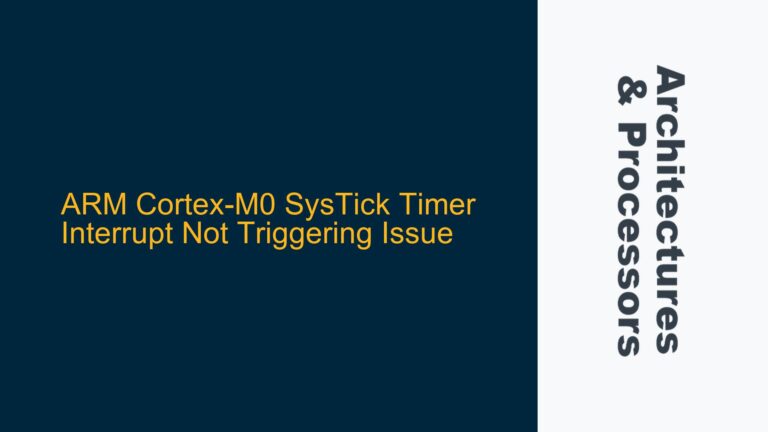ACE Protocol Slave Design Challenges in Multimaster ARM Systems
The ACE (AXI Coherency Extensions) protocol is a critical component in ARM-based systems that require cache coherency across multiple masters, such as CPUs, GPUs, and DMA controllers. The protocol ensures that all masters have a consistent view of memory, even when they are accessing shared resources concurrently. However, designing a slave that adheres to the ACE protocol in a multimaster environment presents several challenges. These challenges stem from the need to handle complex coherency transactions, manage snoop requests, and ensure data consistency across multiple caches.
In a typical ACE-based system, the interconnect acts as the central hub that routes transactions between masters and slaves. The slave, in this context, is responsible for responding to read and write requests, managing coherency states, and handling snoop operations. The complexity arises from the fact that the slave must not only process these requests but also ensure that the data it provides is consistent with the latest updates from all masters. This requires a deep understanding of the ACE protocol, including its various states, signals, and transaction types.
One of the primary challenges in designing an ACE-compliant slave is managing the coherency states. The ACE protocol defines several coherency states, such as Modified, Exclusive, Shared, and Invalid (MESI), which indicate the status of a cache line. The slave must track these states for each cache line it manages and update them based on the transactions it receives. This involves handling snoop requests from the interconnect, which are used to ensure that all masters have a consistent view of memory. The slave must respond to these snoop requests promptly and accurately, updating the coherency states as necessary.
Another challenge is ensuring that the slave can handle the high throughput and low latency requirements of a multimaster system. In such systems, multiple masters may be accessing the same memory location simultaneously, leading to potential conflicts and bottlenecks. The slave must be designed to handle these concurrent accesses efficiently, ensuring that it can process requests from multiple masters without introducing significant delays. This requires careful consideration of the slave’s internal architecture, including its data paths, buffers, and arbitration logic.
Finally, the slave must be designed to handle error conditions and ensure data integrity. The ACE protocol includes mechanisms for detecting and reporting errors, such as parity errors and ECC (Error Correction Code) errors. The slave must be able to detect these errors and take appropriate action, such as retrying the transaction or reporting the error to the master. This requires robust error detection and handling logic, as well as thorough testing to ensure that the slave can handle all possible error scenarios.
Coherency State Management and Snoop Handling in ACE Slaves
The core of any ACE-compliant slave design lies in its ability to manage coherency states and handle snoop requests effectively. Coherency states are critical for maintaining cache consistency across multiple masters, and the slave must be able to track and update these states accurately. The ACE protocol defines four primary coherency states: Modified (M), Exclusive (E), Shared (S), and Invalid (I). Each state represents the current status of a cache line and determines how the slave should respond to read and write requests.
In the Modified state, the cache line has been modified by one of the masters, and the data in memory is stale. The slave must ensure that any read request for this cache line returns the most recent data, which may require writing the modified data back to memory. In the Exclusive state, the cache line is held by only one master, but it has not been modified. The slave can respond to read requests directly from the cache, but it must ensure that any write request updates the coherency state to Modified. In the Shared state, the cache line is held by multiple masters, and the data is consistent across all caches. The slave can respond to read requests from any of the caches, but it must ensure that any write request invalidates the cache line in all other caches. Finally, in the Invalid state, the cache line is not held by any master, and the data in memory is up-to-date. The slave must fetch the data from memory for any read request and update the coherency state accordingly.
Snoop handling is another critical aspect of ACE slave design. Snoop requests are used by the interconnect to ensure that all masters have a consistent view of memory. When a master initiates a read or write request, the interconnect sends snoop requests to all other masters that may have a copy of the cache line. The slave must respond to these snoop requests by providing the current coherency state of the cache line and, if necessary, updating the state based on the transaction. For example, if a snoop request indicates that another master is writing to a cache line that is currently in the Shared state, the slave must invalidate its copy of the cache line to ensure consistency.
Handling snoop requests efficiently requires careful design of the slave’s internal logic. The slave must be able to process snoop requests in parallel with other transactions, ensuring that it does not introduce significant delays. This may involve implementing dedicated snoop handling logic, as well as optimizing the slave’s data paths and buffers to minimize latency. Additionally, the slave must be able to handle multiple snoop requests simultaneously, which may require sophisticated arbitration and prioritization logic.
Optimizing ACE Slave Architecture for High Throughput and Low Latency
To meet the performance requirements of a multimaster ARM system, the ACE slave must be optimized for high throughput and low latency. This involves careful consideration of the slave’s internal architecture, including its data paths, buffers, and arbitration logic. The goal is to ensure that the slave can process requests from multiple masters concurrently, without introducing significant delays or bottlenecks.
One key aspect of optimizing the slave’s architecture is designing efficient data paths. The slave must be able to handle multiple read and write requests simultaneously, which requires parallel data paths and buffers. For example, the slave may include separate data paths for read and write requests, as well as dedicated buffers for storing incoming and outgoing data. This allows the slave to process multiple transactions in parallel, reducing the overall latency and improving throughput.
Another important consideration is the design of the slave’s arbitration logic. In a multimaster system, multiple masters may attempt to access the same memory location simultaneously, leading to potential conflicts. The slave must include arbitration logic to resolve these conflicts and ensure that all requests are processed fairly. This may involve implementing a priority-based arbitration scheme, where certain masters are given higher priority based on their role in the system. For example, a CPU master may be given higher priority than a DMA controller, as it is typically more sensitive to latency.
In addition to arbitration, the slave must also include mechanisms for handling burst transactions. Burst transactions are used to transfer large blocks of data between the master and the slave, and they are common in high-performance systems. The slave must be able to handle burst transactions efficiently, ensuring that it can process the entire burst without introducing significant delays. This may involve implementing dedicated burst handling logic, as well as optimizing the slave’s data paths and buffers to support high-speed data transfers.
Finally, the slave must be designed to handle error conditions and ensure data integrity. The ACE protocol includes mechanisms for detecting and reporting errors, such as parity errors and ECC (Error Correction Code) errors. The slave must be able to detect these errors and take appropriate action, such as retrying the transaction or reporting the error to the master. This requires robust error detection and handling logic, as well as thorough testing to ensure that the slave can handle all possible error scenarios.
In conclusion, designing an ACE-compliant slave for a multimaster ARM system is a complex task that requires a deep understanding of the ACE protocol, as well as careful consideration of the slave’s internal architecture. By focusing on coherency state management, snoop handling, and performance optimization, it is possible to design a slave that meets the demanding requirements of modern ARM-based systems.






